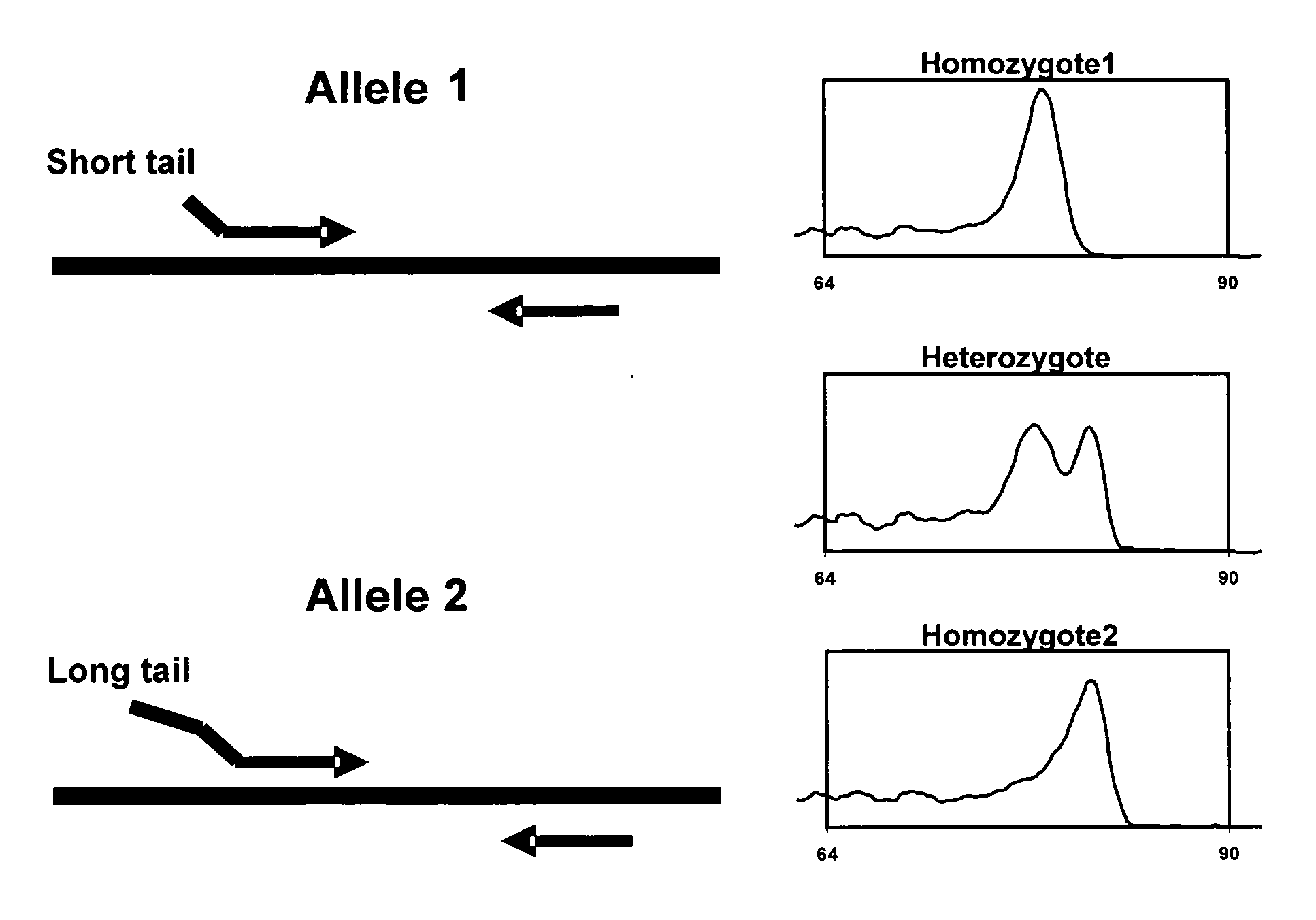Methods of genotyping using differences in melting temperature
a technology of melting temperature and genotyping method, applied in the field of genotyping using melting temperature differences, can solve the problems of high cost of materials, difficult and challenging task of identifying complex biological traits that are affected by multiple genetic and environmental factors,
- Summary
- Abstract
- Description
- Claims
- Application Information
AI Technical Summary
Benefits of technology
Problems solved by technology
Method used
Image
Examples
example 1
14 b, and 6 bp 5′ Regions
[0064] PCR reactions are performed on genomic DNA in 100 μl reaction volumes. Reaction and cycling conditions are optimized to conditions as described below to minimize non-homologous allele amplification and primer-dimmer formation. A modified (termed “gold” ) version of Taq Stoffel fragment DNA polymerase, prepared in-house (as per U.S. Pat. No. 5,677,152 and U.S. Pat. No. 5,773,258), is used to provide a hot start to the reaction. For each nucleotide polymorphism site having 1 polymorphic base site with 2 possible alleles, two forward primers are designed with the terminal 3′ base of each primer matching only one of the polymorphic bases. The 5′ end of each forward primer comprises GC-rich sequences; one primer having a 14-base-long 5′ end non-complementary to the target DNA and the second primer having a 6-base-long 5′ end non-complementary to the target DNA (see underlined sequence, TABLE 1). Common reverse primers are designed downstream of each polym...
example 2
10 bp and 3 bp 5′ Regions
[0068] PCR is performed as per the reaction conditions and analysis methods as described above in Example 1, with the following modifications. PCR reactions are performed with 10 ng of genomic DNA in 50 μl reaction volumes. The 5′ end of each forward primer comprises GC-rich sequences, one primer having a 10-base-long 5′ end non-complementary to the target DNA and the second primer having a 3-base-long 5′ end non-complementary to the target DNA (see underlined sequence, TABLE 2).
TABLE 2PrimerPolymorphismNameDescriptionSequence 5′-3′AC006408.1_51078JWG1202Allele 1GCGGGCAGGGTGCACCTTTTGGACATTC(SEQ ID NO-16)JWG1203Allele 2GCGTGCACCTTTTGGACATTT(SEQ ID NO-17)JWG1204CommonGAACGCACGTCCCTTGTC(SEQ ID NO-18)AC006408.1_45311JWG1205Allele 1GCGGGCAGGGCCGTGTTTGACTCAACTCAG(SEQ ID NO-19)JWG1206Allele 2GCGCCGTGTTTGACTCAACTCAA(SEQ ID NO-20)JWG1207CommonTTTGCCGGAAATATTAGCGT(SEQ ID NO-21)AC006408.1_65008JWG1208Allele 1GCGGGCAGGGTTGTGCAGCCCTAAAGG(SEQ ID NO-22)JWG1209Allele 2GC...
example 3
26 bp and 18 bp 5′ Regions
[0070] PCR is performed as per the reaction conditions and analysis methods as described above in Example 1, with the following modifications. PCR reactions are performed with 10 ng of genomic DNA in 50 μl reaction volumes. The 5′ end of each forward primer comprises GC-rich sequences; one primer having a 26-base-long 5′ end non-complementary to the target DNA and the second primer having an 18-base-long 5′ end non-complementary to the target DNA (see underlined sequence, TABLE 3).
TABLE 3PrimerPolymorphismNameDescriptionSequence 5′-3′AC006408.1_51078JWG1214Allele 1GCGGGCAGGGCGGCGGGGGCGGGGCCTGCACCTTTTGGACATTC(SEQ ID NO-28)JWG1215Allele 2GCGGGCAGGGCGGCGGGGTGCACCTTTTGGACATTT(SEQ ID NO-29)JWG1216CommonGAACGCACGTCCCTTGTC(SEQ ID NO-30)AC006408.1_45311JWG1217Allele 1GCGGGCAGGGCGGCGGGGGCGGGGCCCCGTGTTTGACTCAACTCAG(SEQ ID NO-31)JWG1218Allele 2GCGGGCAGGGCGGCGGGGCCGTGTTTGACTCAACTCAA(SEQ ID NO-32)JWG1219CommonTTTGCCGGAAATATTAGCGT(SEQ ID NO-33)AC006408.1_65008JWG1220A...
PUM
| Property | Measurement | Unit |
|---|---|---|
| Length | aaaaa | aaaaa |
| Melting point | aaaaa | aaaaa |
| Fluorescence | aaaaa | aaaaa |
Abstract
Description
Claims
Application Information
 Login to View More
Login to View More - R&D
- Intellectual Property
- Life Sciences
- Materials
- Tech Scout
- Unparalleled Data Quality
- Higher Quality Content
- 60% Fewer Hallucinations
Browse by: Latest US Patents, China's latest patents, Technical Efficacy Thesaurus, Application Domain, Technology Topic, Popular Technical Reports.
© 2025 PatSnap. All rights reserved.Legal|Privacy policy|Modern Slavery Act Transparency Statement|Sitemap|About US| Contact US: help@patsnap.com


